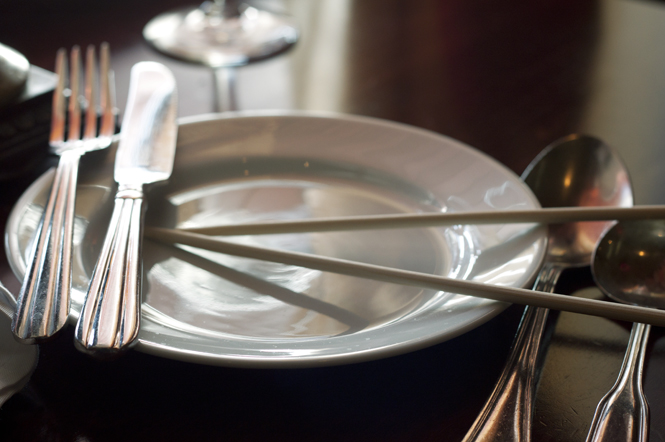Fork to spork, the evolution of utensils
February 17, 2011
Utensils are probably some of the most underrated and overlooked items in our day-to-day lives. Unless you find yourself trying to eat soup with a fork, it’s unlikely that you give much thought to the silverware aiding you in digging into that pasta or prime rib. But where did that entire cutlery come from?
A look at portion sizes
With the modern weight loss obsession, many people stress about “portion distortion.” Diners now have to worry less about their eyes being bigger than their stomachs, than about their meals being bigger. The national average for restaurant portion size has doubled, and in some cases even tripled or quadrupled in just the past 20 years. Here are a few comparisons between then and now, courtesy of the USDA (http://www.usda.gov).
Bagel
- 1990 – three-inch diameter, 140 calories
- 2010 – six-inch diameter, 350 calories
French Fries
- 1990 – 2.4 ounces, 210 calories
- 2010 – 6.9 ounces, 610 calories
Spaghetti and Meatballs
- 1990 – one cup of pasta with sauce and three small meatballs, 500 calories
- 2010 – two cups of pasta with sauce and three large meatballs, 1,025 calories
Chicken Stir Fry
- 1990 – two cups, 435 calories
- 2010 – four and a half cups, 865 calories
Coffee
- 1990 – Coffee (with whole milk and sugar), eight ounces, 45 calories
- 2010 – Coffee (with steamed whole milk and mocha syrup), 16 ounces, 350 calories
Soft Drink
- 1990 – 6.5 ounces, 85 calories
- 2010 – 20 ounces, 250 calories
Rick Feinberg, professor of anthropology, said that diet plays a key role in determining why different cultures develop or adopt the utensils they use.
“People in different parts of the world use different things to eat with,” Feinberg said. “In some places, people use forks and knives and spoons, in some places people use chopsticks, some places people use fingers. In some of the places where I’ve worked (the Pacific Islands), they started using things like spoons for soups and rice, which is a new food for people in the area. In some places people eat off leaves on mats on the floor, (and in) some places people eat on tables like they do here.”
No matter what people use to set their tables, there’s a good chance those utensils are the result of centuries of refinement.
Knives
Knives have been around since the first caveman realized he had to eat. Early knives were used for hunting, food preparation and defense, in addition to eating. The knife’s role has changed little since then. Back in the day, when knives were the only utensils available, food was cut, then speared on the knife tip and brought to the mouth.
This method work perfectly well until 1669 when King Louis XIV of France banned knives in an effort to reduce the crime rate. People had no other utensils, so they began filing down their knives to give them blunt ends. This led diners to scoop food, rather than pierce it, making room for the spoon to gain popularity. The blunt dinner knife lost its prominence with the introduction of the Italian fork and became what we now know as a “butter knife.”
Forks
Forks were first used by the Greeks to steady meat for carving and serving. The first forks were large and two-tined, like today’s serving forks. They gained popularity in the Byzantine royal courts and were finally brought to Italy in the 11th Century.
Forks were introduced to the rest of Europe in 1533 following the marriage of Henry II to Catherine de Medici, who brought forks with her to England from France. At first, only the wealthiest members of English society used forks, and the model was ridiculed for being too feminine a utensil.
The smaller, modern multi-tined fork was developed in France near the end of the 17th Century but was considered a luxury item until the early 19th Century when Americans adopted the fork.
Spoons
Spoons have been around almost as long as knives. The pre-modern man used shells or chips of wood to scoop food into the mouth. The Romans developed a “ligula” spoon with an oval bowl to eat soups and a “cochlear” spoon with a round bowl for shellfish and eggs. These two spoons were improved over time into the modern spoon and soupspoon.
By the Middle Ages, spoons were used in all of Europe and were usually made of wood, iron, silver, gold or, most commonly, pewter.
Chopsticks
Chopsticks have been in use for almost 5,000 years. Invented in China, chopsticks were developed out of necessity during a widespread fuel shortage. All food had to be cut into tiny pieces to make it cook faster, wasting less fuel. The first chopsticks were constructed like tweezers in order to pluck small bits of food from cooking pots. Today, wooden chopsticks are still popular in China, Vietnam, Korea and Japan.
Sporks
The name, “spork,” was first trademarked in 1969 by the Van Brode Milling Co., Inc., of Massachusetts to describe “a piece of cutlery combining the features of a spoon, a fork and sometimes a knife.” However, there are many other trademarks and patents for various spork designs, and its origins are a mystery.
Poet Edward Lear describes a “runcible spoon” in his poem, “The Owl and the Pussycat,” published in 1871, which shares many of the spork’s qualities. Perhaps Lear invented the spork.
All information comes from the California Academy of Sciences online database.
Contact Amy Cooknick at [email protected].
























